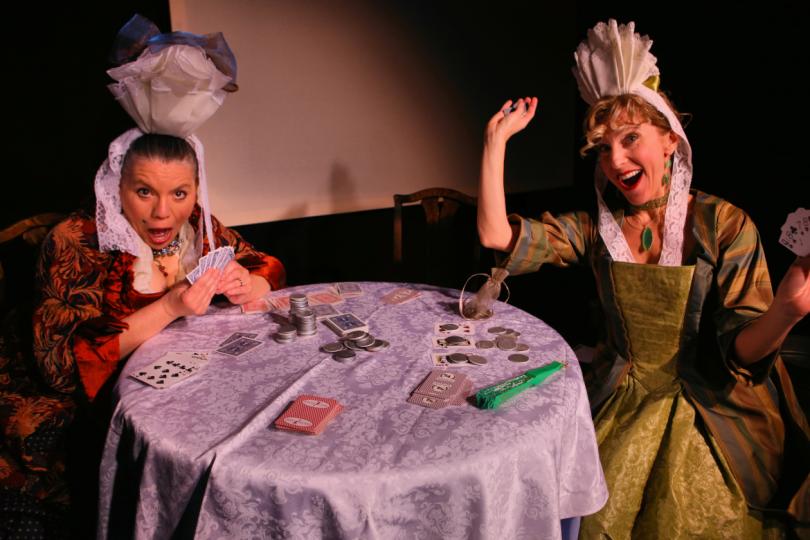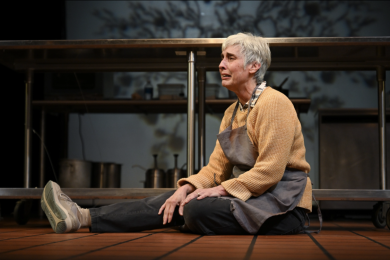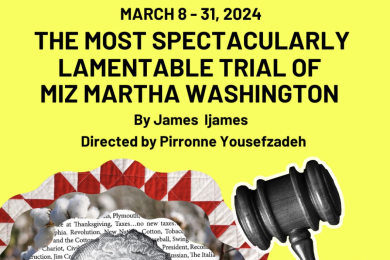The Basset Table

When you go to an all women’s school you don’t need separate Women’s Studies Department because every class is already cleverly designed in a women’s studies slant. As a theatre student at Smith College, I was lucky to be exposed to some pretty amazing female playwrights; Lillian Hellman, Edna Ferber, Lorraine Hansberry, Wendy Wasserstein, Caryl Churchill, Yasmina Reza, Marsha Norman, Paula Vogel, Pearl Cleague, (to name a few favorites), and of course, Aphra Behn. So, you’ll understand why, I was amazed and confused that I had never heard of 18th century playwright, Susanna Centlivre! I’m still paying off that private liberal arts education and you’d think I’d earned the information! Thank goodness, I saw Persistent Theatre Production’s sophomore selection The Basset Table on Opening Night (PTP produces TBT see what I did there?) and was finally introduced to the wordsmith-ing of Ms. Centlivre.
First of all, what the heck is a Basset Table? Basset, consequently, is a game of gambling that was introduced in England around 1677. Ironically, it never caught on outside Court circles on account of it’s costliness and the heavy financial risks it inflicted on players. Originally from France the game had significantly more regulations and restrictions, but in England the punters (or gamblers) could be found staking anything from one guinea to one hundred guineas and more, upon a card. After three or four years, many players had impoverished their families to such an extent that Parliament enacted a prohibition with severe penalties against games. Basset’s high stakes, along with its personal devastations, are the subject of Susanna Centlivre’s 1705 comedy.
This restoration piece highlights the notion of female professional and financial independence. Introducing LADY REVELLER (Julie Ann Grief), a widowed woman who has discovered her love for gambling and personal freedom; MRS SAGO (a kooky Judy Bee), a manipulating married woman who is embezzling her husbands fund so she can continue to play some cutthroat cards; VALERIA (Lana Bean), a young lady scientist who will settle for nothing but an intellectual matrimonial match; ALL while the men in their lives complain about these respective quirks, as things to be dealt with or endured instead of embraced.
Many people feel, (including director Meggie Greivell), that Centlivre plays often express liberal feminist points of view, “that she wrote frankly in the face of strong sexual morals, and managed to push the boundaries of social norms.” The fact that the women are the focal point of the play, with three dimensional characters, is a feat in itself. Not to mention the fact that the female scholar (a female scholar? zounds!), has her own microscope is remarkable, as “microscopes were rare in this time even for male scientists to own, let alone a woman” Greivell notes in the program. I get it, it’s progressive for the time, I just don’t know if it’s worth excusing the time to still watch women being undermined and ridiculed even IF it’s their story being told on stage. Yes, they may get what they want and use their feminine wiles to twist their husbands arms, but It’s not fun to watch them be conniving while the men laugh ‘knowingly’ and roll eyes at the feigned frailty.
PTP’s production is respectable. The ensemble is capable, the language is clear, and dialects consistent. Rebecca Karstad’s 18th century costumes are ambitious and fun and fit the variety of body types she’s working with. Greivell is tasked with the difficulty of staging this twelve person period piece in the Dreamland Arts Space which, albeit cozy, is a mere 22’x30’ of stage space and doesn’t account for masked back or off stage areas. It is tight to say the least, and although she uses levels and lights to illustrates the change of locations (thank you for not scene changing everything) it often reads as cramped and therefore comprises some of the more physical scenes. There is a sword fight, for instance, that was very worrisome. The actors didn’t have room to take their swords out of their belt loops, let alone extend to an arms length of a realistic fight. Also, why make actors come out into the audience before the show? This is not a rhetorical question. I have seen this so many times, I have been in these shows, and there are few (if any) occasions I have felt it added to my overall experience. It just feels awkward. Aside from that and a very odd and uncomfortable assault scene, the show was enjoyable. A highlight for me was ENSIGN LOVELY (a foppish Franklin Wagner) trying to disguise himself as a rough and tumble Sea Captain behind a ridiculously fake mustache and faux bravado!
Ultimately my question then becomes, why this play? The Basset Table only ran for four nights after it’s premier and was never revived, and though Persistent Theatre Productions (choosing plays to highlight women who “have been overlooked for far too long not only in theatre but our world”) does a decent job tackling the genre, I’m not convinced this play needs more stage time than has already been allotted. Meh, progressive for “the time” is good for the time. I’m not sure if this play is enough to hold my attention, or earns enough feminist power points to combat my annoyance of how NOT progressive it is for THIS time. Greivell, who states that Centlivre has been “vastly forgotten until recently,” may have hit upon something. I think there are other plays and playwrights that better capture the female struggle. Hmm, perhaps my all women’s education didn’t do me too much of a disservice after all. You have one more weekend to check out the foibles around The Basset Table and support PTP.




